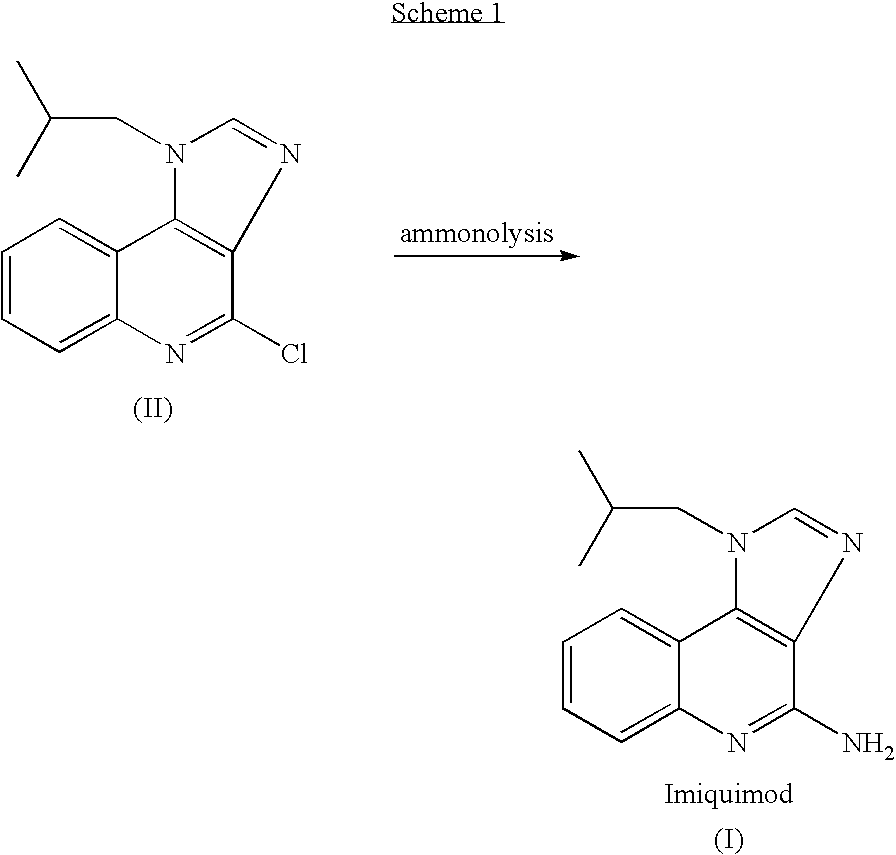Imiquimod production process
- Summary
- Abstract
- Description
- Claims
- Application Information
AI Technical Summary
Benefits of technology
Problems solved by technology
Method used
Image
Examples
example 1
[0048]This example demonstrates the preparation of imiquimod by reaction of compound II with ammonia in DMSO at 140-150° C. under a pressure of about 5 bar.
[0049]A 250 glass reactor “Miniclave” was charged with 4-chloro-1-isobutyl-1H-imidazo [4,5-c]quinoline (II) (20 g, 0.0733 mol) and DMSO (50 ml). Ammonia gas (2 g, 0.118 mol, 1.6 equiv.) was added into the closed reactor and the mixture was heated under stirring to 145-150° C. to obtain a pressure sustaining a glass reactor of about 5 bars. After heating at 140-150° C. for 10 hours the pressure was reduced to atmospheric pressure and the reaction mixture was cooled to ambient temperature. A sample was withdrawn and injected to an HPLC system. According to the HPLC chromatogram the product contained 51% of imiquimod and 49% of the compound II in the reaction mixture.
[0050]Then, a second portion of ammonia gas (2 g) was added into the closed reactor at ambient temperature followed by heating the reaction mixture to 145° C. to obtain...
example 2
[0051]This example demonstrates the preparation of imiquimod by reaction of compound II with ammonia in DMSO at 140-150° C. under a pressure of about 5 bar.
[0052]A 250 glass reactor “Miniclave” was charged with 4-chloro-1-isobutyl-1H-imidazo [4,5-c]quinoline (II) (20 g, 0.0733 mol) and DMSO (50 ml). Ammonia gas (2 g, 0.118 mol, 1.6 equiv.) was added into the closed reactor and the mixture was heated under stirring to 145-150° C. to obtain a pressure sustaining a glass reactor of about 5 bars. After heating at 140-150° C. for 10 hours the pressure was reduced to atmospheric pressure and the reaction mixture was cooled to ambient temperature.
[0053]Then, a second portion of ammonia gas (2 g) was added into the closed reactor at ambient temperature followed by heating the reaction mixture to 145° C. to obtain a pressure of about 5 bar. The heating was continued for 6 hours during which time the pressure was reduced to 2.5 bar. The reaction mixture was cooled to ambient temperature and a...
example 3
[0055]This example demonstrates the purification of imiquimod by slurrying crude imiquimod, containing 8% of 4-chloro-1-isobutyl-1H-imidazo[4,5-c]quinoline, in methanol.
[0056]A suspension of crude imiquimod (2 g, containing 8% of 4-chloro-1-isobutyl-1H-imidazo[4,5-c] quinoline) in methanol (14 ml) was stirred under reflux for 4 hours. The hot mixture was then filtered off and the obtained solid was washed with methanol and dried at 60° C. overnight to afford 1.9 g of pure imiquimod in 95% yield, having 99.89% purity (by HPLC).
PUM
| Property | Measurement | Unit |
|---|---|---|
| pressure | aaaaa | aaaaa |
| temperature | aaaaa | aaaaa |
| diameter | aaaaa | aaaaa |
Abstract
Description
Claims
Application Information
 Login to View More
Login to View More - R&D
- Intellectual Property
- Life Sciences
- Materials
- Tech Scout
- Unparalleled Data Quality
- Higher Quality Content
- 60% Fewer Hallucinations
Browse by: Latest US Patents, China's latest patents, Technical Efficacy Thesaurus, Application Domain, Technology Topic, Popular Technical Reports.
© 2025 PatSnap. All rights reserved.Legal|Privacy policy|Modern Slavery Act Transparency Statement|Sitemap|About US| Contact US: help@patsnap.com



